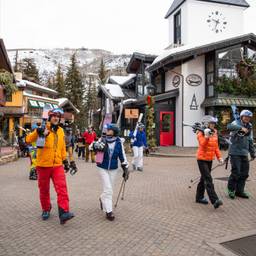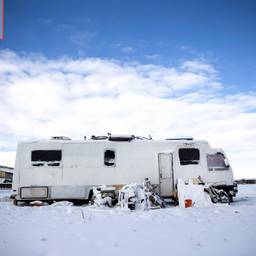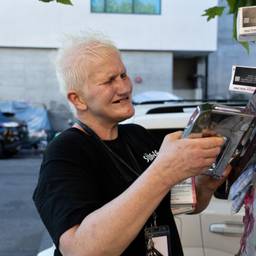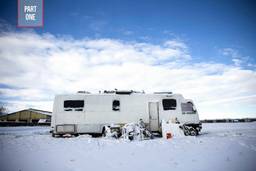How To Privatize a Mountain
As a wave of wealth sweeps Montana, landowners are blocking the public from public lands.
Joseph Bullington
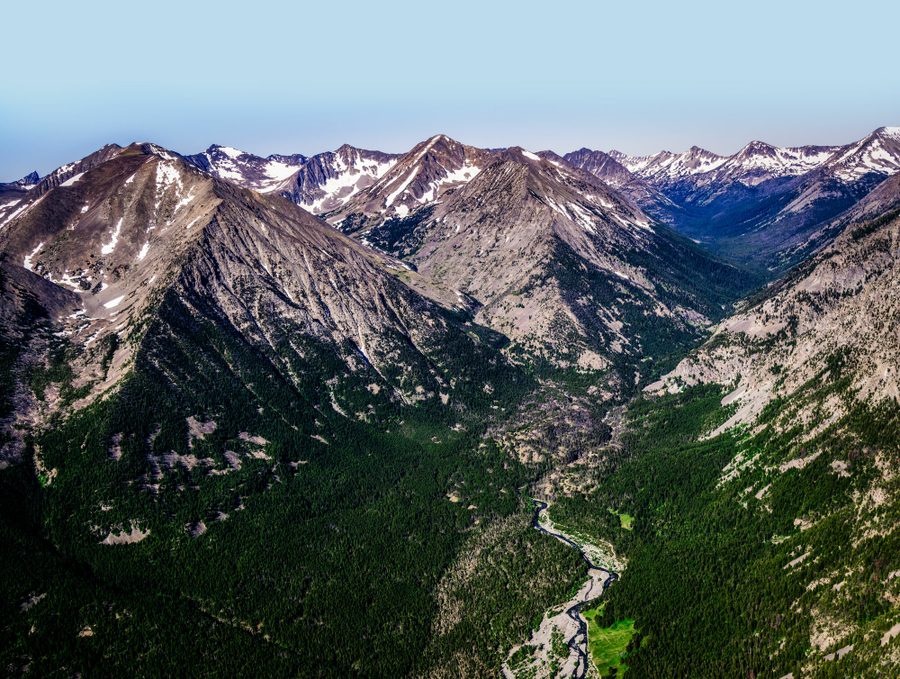
In Montana’s Crazy Mountains, private landowners have restricted access to public lands, including in the Sweet Grass Creek drainage, shown here. PHOTO BY BRUCE GORDON/ECOFLIGHT
We had followed the trail for a half mile when it ran headlong into a fence.
Signs nailed to the trees blared messages of unwelcome: “Private Property” and “No Forest Service Access.” They were emphatic: The trail ends here.
Our map — the official map of the Custer Gallatin National Forest — said different: The trail continued for another seven or eight miles, a substantial orange line winding through the foothills of Montana’s Crazy Mountains.
The signs, though, had the desired effect. On the other side of the fence, the trail grew faint.
This trail, known as the Porcupine Lowline, had been marked on U.S. Forest Service maps for nearly a century — the earliest I’ve seen is dated 1925. But, like many trails in the Crazies, it crossed private land to reach the National Forest. And, like many trails here, landowners had taken to putting up “No Trespassing” signs, fences and padlocked gates at those crossing points. The practice is so widespread that the Forest Service counts only one remaining public access point along the Crazy Mountains’ entire 16-mile southeastern flank.
Practically speaking, this means private landowners have made it much more difficult for the public to access more than 22,000 acres of Custer Gallatin National Forest land.
Which is why I was there that day, in October 2018, with two friends, all three of us reporters at the local newspaper. I wanted to understand the disputed trails by walking them.
We crossed the fence with little ceremony and followed the trail past the signs and into the tree shadows beyond.
These mountains haven’t always felt like hostile territory. At an hour’s drive south of my hometown of White Sulphur Springs, Mont., the Crazies were one of our backyard ranges, though steeper, wilder and stranger than the others. My family often camped here, and through my teenage years, my dad, my younger brother and I took a week most summers to disappear into the high Crazies. We’d strap packs across our bony backs, stagger several miles into the mountains, and make camp in our favorite spot: a high-altitude meadow of flowers and grouse whortleberries blooming lush and absurd between snowfield and scree. A trickle of snowmelt cuts a groove through this carpet of greenery, and altitude-stunted hedges of spruce and whitebark pine offer firewood. Looming over it all, a massive cone of raw diorite: Crazy Peak, 11,214 feet tall, the highest point in the range.
My family, it turns out, has a rich tradition of trespassing. The meadow where we camped and Crazy Peak itself, I’ve since learned, were owned by a local ranch. While most of the Crazies are public land managed by the Forest Service, they are checkered with these square-mile sections of private land. That’s because, in an 1864 land grant to subsidize construction of transcontinental railways and promote colonization of the West, the U.S. government transferred every other section in the Crazies and elsewhere to the Northern Pacific Railway, up to 20 sections for every mile of track the company built. This created the checkerboard ownership pattern that troubles maps to this day. (This land wasn’t exactly the government’s to offer up: Four more years would pass before the Crow Nation officially ceded the Crazies to the United States.)
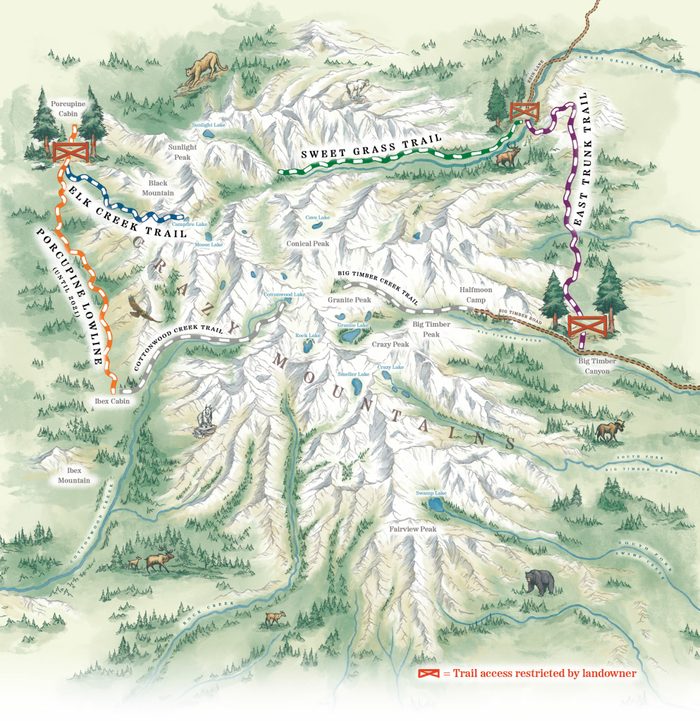
If my dad knew this was private land — and I doubt he did— he kept it to himself. So did the owners, back then: As we explored the Crazies, we never met a “No Trespassing” sign or a locked gate. Although it’s hard to explain it to newcomers, this was the prevailing culture at the time: You could generally walk in the mountains without worrying whose land you were on, and if you wanted to hunt on private land, you could call or stop by the house for permission.
In the years after my dad died in 2013, I returned to the Crazies often to camp, fish, cut firewood, pick berries, hunt elk, fall down snowfields, limp home. I no longer took the Crazies for granted. Here was land where otherwise landless people could go without having to pay or grovel permission from some capricious baron. Here they could stock up their woodpiles and freezers, take their kids camping, shamble about studying the plants, or just build a big fire and drink beer with friends. These places are the bedrock of a proletarian rural culture that values subsistence, independence and living close to the land.
I also saw that the Crazies were rapidly changing. A great many inholdings, including Crazy Peak and the meadows below it, had recently been sold to Switchback Ranch LLC, owned by billionaire private equity investor David Leuschen. And the company had plans for this property. One day, I followed a helicopter to a cabin construction site by an alpine lake on one of the company’s inholdings, 8,000 feet up and miles from a road. The area bristled with fresh “No Trespassing” signs.
Meanwhile, down in the foothills, other landowners were choking off public access routes and effectively privatizing vast swaths of the mountains.
What was going on here?
The Crazies, it seems, have been swept up in the wave of wealth and gentrification that is reshaping the West — driving up housing costs in nearby towns, displacing working-class residents and carving up the landscape for profit. Among the newcomers to the Crazies is CrossHarbor Capital Partners, which owns the Yellowstone Club, an ultra-exclusive residential development near Big Sky that boasts the only private ski and golf resort in the world and where membership costs millions of dollars. In 2021, CrossHarbor bought (through one of its subsidiary companies) the 18,000-acre Crazy Mountain Ranch and later announced plans for two golf courses. “As incredible a setting [as] there will ever be for the game of golf,” says the website. The company plans to run the ranch as “a private membership experience.”
The real money in the New West is found less in mining, logging and ranching than in selling such exclusive wilderness experiences: remote luxury “cabins,” fly fishing tours, guided hunts for trophy elk, mountain biking and (apparently) golf. But in Montana — where about 35% of the land, most of the mountains and all of the rivers and wildlife belong to the public — creating exclusive experiences often depends on exclusion.
Brad Wilson has watched with growing frustration as “No Trespassing” signs have overrun the Crazies. His family homesteaded here in the 1870s, and Wilson, pushing 70 now, has spent a lifetime exploring these mountains on foot and horseback. His grandfather sold the family place in the 1960s, and Wilson joined that particularly Western class of people with ranch skills but no ranch — and little prospect of ever being able to buy one. So he cowboyed, did a stint as a deputy sheriff, worked as an equipment operator for the county.
“Most of us folks who’ve lived here all our lives, we have eked out a mere existence here,” Wilson says. “We could have went anywhere else and made a hell of a lot more money, but I chose to live here for specific reasons.” Those reasons have to do with the land. “These mountains always drew me back here ’cause I felt free here,” he says.
Maybe the money wasn’t good, but you didn’t need money to backpack with your wife to Campfire Lake in early summer, when clots of white wool adorn the bushes from mountain goats rubbing off their winter coats. You didn’t need money to walk miles of uncrowded trail, where you might pass other locals but also people out for the weekend from Bozeman or Billings (or even Baltimore or Bucharest — the public lands of the Crazies are free to anyone who can get there). You didn’t need money, or much of it, to stack up a good woodpile or put an elk or two in the freezer: A firewood permit on the National Forest costs a few dollars, an elk license costs $20.
But as hunting becomes big business in the West, a license only gets you so far. When I talked to Wilson recently, he’d been calling around looking for a place a friend of his could hunt, but landowners kept giving him the same answer: No, we’ve got the hunting rights leased to an outfitter.
In Montana, as across the United States, wild animals like elk legally “belong” not to property owners but to the public at large. However, landowners can turn a profit from these creatures by charging “trespass fees” for hunting access to or through their property, or by selling guided hunts, which can cost thousands of dollars.
There is plenty of public land in the Crazies where you can hunt for free. Trouble is, because of blocked access, you increasingly can’t get to it, and what you can get to has more hunters on it and less elk. Many low-lying sections of public land here are — because of the land-grant checkerboard— islands surrounded by private land, accessible only by way of these disputed lowline trails. In other cases, the blocked trails just make access harder, sometimes much harder.
Wilson founded Friends of the Crazy Mountains (a group that advocates for public access here) after landowner Ned Zimmerman fenced off the Porcupine Lowline — and so blocked Wilson from the shortest route to, among other places, Campfire Lake. The same is true of public lands along Sweet Grass Creek, a main drainage on the range’s east side. Because landowners control access, the public can reach the area only by begging permission or undertaking a grueling 10- or 20-mile trek from the other side of the range.
In short, by blocking accesses, landowners can reduce or eliminate the public from these public lands and can in turn provide exclusive access for themselves and their paying customers.
Take, for example, the Rein Anchor Ranch, one of the landowners that controls access up Sweet Grass Creek. Chuck Rein, former president of the Montana Outfitters and Guides Association, also happens to hold an outfitting permit to guide hunts on the National Forest lands accessed by Sweet Grass Trail. The Reins offer a menu of hunts that includes elk ($5,550), elk and mule deer ($7,400) and mountain goat ($5,500). Reached by phone, the Rein Anchor Ranch declined to be interviewed for this story.
Likewise, Sweet Grass Ranch — a dude ranch where a weeklong stay starts at $2,600 per person— obstructs public use of Sweet Grass Trail. It, too, holds an outfitting license to take clients onto the National Forest lands accessed by the trail. Sweet Grass Ranch did not respond to multiple requests for comment.
In a 2013 email to other Forest Service employees, Yellowstone District Ranger Alex Sienkiewicz summarized the situation this way: “The Crazy Mountains have basically been appropriated by a bunch of landed rancher-outfitter businessmen … The public wildlife on this land has been appropriated by these same people and their ‘hunting clubs.’” (The email is part of a batch of Forest Service documents obtained through the Freedom of Information Act and shared with me by access advocate Kathryn QannaYahu Kern.)
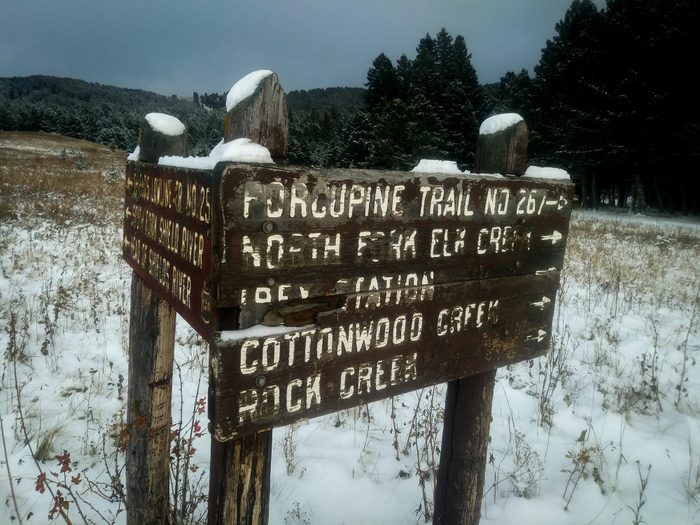
The early forest rangers who rode their work hitches on these trails did not secure recorded (or “perfected”) easements across some sections of private checkerboard. Many — if not most — accesses to public land in the state lack perfected easements, says Drewry Hanes, public access consultant at the Public Land Water Access Association (PLWA), which researches public access in Montana. If all such unperfected accesses were closed overnight, she says, the Forest Service could be cut off from more than half of its roads.
Long histories of public use and maintenance with public funds make many of these sections of trail good cases for prescriptive easements, which are based on historic use and are awarded retroactively by a court, Hanes says. But until and unless a court weighs in, these trails are vulnerable. Under Montana law, by blocking trails and allowing only “permissive” use for five years, landowners can build a case to extinguish public trail rights forever.
According to Hanes, landowners are targeting these vulnerable routes not only in the Crazies but across the region. A 2015 letter by Custer Gallatin National Forest Supervisor Mary Erickson cited 10 “disputed or lost access points” in the Yellowstone District in the past decade. PLWA has received 40 complaints about blocked public land accesses across Montana just since it began fielding them in 2022.
One of the biggest problems, says Hanes, is getting government agencies to do something about obstructed routes. “If I trespass on someone’s land, I’ll get a ticket within an hour,” she says. “If I [illegally] block off the public’s access to a river … there might never be a citation.”
District Ranger Sienkiewicz (pronounced Sen-kev-itch) declined to be interviewed for this story, but Forest Service documents from 2013 to 2017 show him waging a campaign to defend the agency’s claim to the obstructed Crazies trails. He met with landowners to insist they remove trail obstructions, wrote to county officials, led maintenance crews on the disputed trails and advised Forest Service employees not to ask landowner permission to use them: “By asking permission,” he wrote, “one undermines public access rights and plays into their lawyers’ trap of establishing a history of permissive access.”
Sienkiewicz seemed to be acting in line with agency policy of “defending historic trail access rights if challenged,” as one 2002 Forest Service briefing paper put it. But the ranger’s approach angered some landowners who, in late 2016 and early 2017, complained about his “aggressive attitude” in letters to his Forest Service higher-ups, Montana Republican Sen. Steve Daines and Sonny Perdue, then-Secretary of Agriculture. (The Department of Agriculture oversees the Forest Service.) The ranger, they said, was encouraging trespass to re-establish long-abandoned trails. Daines met with a group of Crazy Mountain landowners and, in a May 2017 letter, passed their concerns on to Thomas Tidwell, then-Forest Service Chief.
A few weeks later, the Forest Service abruptly removed Sienkiewicz from his post as district ranger, reassigned him to a role in the Forest Supervisor’s Office and announced an investigation into his conduct.
By October 2018, when my friends and I set out to walk the Porcupine Lowline, we found that years of obstruction or inconsistent maintenance, or both, had taken their toll on the old trail. For one thing, the waymarking signs and blazes you expect on a Forest Service trail were missing — all day we passed only one. Where the route intersected animal trails and logging roads, we puzzled over map and compass. By late afternoon, with the sun sinking low, we were lost.
It was then we heard approaching motors. The man in the lead ATV told us we were on a private ranch. His name, we found out later, was Dave Laubach, the ranch manager and a managing member of a hunting club that operated in the area. I told Laubach we were on the Porcupine Lowline. He told us we weren’t. He was right: At one of those unmarked intersections, we understood later, we had strayed from the trail. (In a 2013 letter to landowner Ned Zimmerman, whose fence blocking the Porcupine Lowline we’d crossed earlier that day, Sienkiewicz had accused Laubach and Zimmerman of taking down these trail signs: “When Government signage, boundary markers and blazes are destroyed, you are inviting the very trespass that you and your colleagues are blaming on the Forest Service.”) We were maybe 100 yards from National Forest land when Laubach caught up with us. After some disagreement, we went on our way.
The next day, a Park County Sheriff ’s deputy found us at the newspaper office and wrote us citations for criminal trespass.
We had, in short, gotten what we’d naively bargained for: We had learned what it was like to try to walk one of these disputed trails, and we had the court dates to prove it.
Reached for comment, Laubach said we had walked a long way on private property and that Sienkiewicz’s charge that he had destroyed trail markers was “totally false.” He also said he and Zimmerman had met with Sienkiewicz and Forest Supervisor Mary Erickson to dispute that allegation. He added, “There has been no proof that anyone has destroyed trail markers.”
His wife, Mary Laubach, put in: “We’re just normal hardworking people and we’re not blocking public access.”
Zimmerman declined to be interviewed by phone but sent a brief response to an emailed list of questions. In regards to his decision to fence off access to the Porcupine Lowline, he wrote, “the Forest Service was making use claims on our property which we knew were beyond their legal authority. … They had no written easement. In order to demonstrate that we were not acquiescent to these claims we locked the gates to our property.”
Sienkiewicz was eventually reinstated as district ranger in October 2017 and the Forest Service released no evidence of wrongdoing, but his transfer marked a change in the agency’s tone. The documentation of trail use, the letters asserting the agency’s claims, the maintenance crews — “that all stopped after Alex was reassigned,” says Matthew Bishop, a lawyer with the Western Environmental Law Center who reviewed troves of Forest Service records as he prepared to sue the agency on behalf of four access groups, including Friends of the Crazy Mountains and the Montana Chapter of Backcountry Hunters and Anglers. The lawsuit, filed in 2019, argues in part that “since 2017, the Service has effectively abandoned its responsibility to manage the four trails for public access.”
In response, the agency stunned many observers by dismissing some of the trails as already lost. It argued that, by 2018, its prescriptive claims on some trails had likely “been reversed and extinguished” by years of little maintenance, low use and landowner trail obstructions.
A federal judge ruled against the access groups.
Sienkiewicz, in emails, had warned Forest Service employees and his bosses at least as early as 2013 that the agency was losing its claims on the trails, adding that the agency’s failure to act “undermines the heart of the USFS mission” and represents “a failure of leadership at all levels.”
Instead of suing to perfect its easements, the agency focused on negotiating with landowners. This strategy had its advantages: In short order, it worked out a deal with Zimmerman in which the agency agreed to abandon the Porcupine Lowline and Zimmerman agreed to a permanent easement for a new trail to cross a corner of his land. While the new trail, completed in 2021, sidehilled through steeper, forested terrain instead of the grassy foothills, it lay mostly on the National Forest and provided undisputed access to the same public lands. Our hapless expedition put my friends and me among the last people to walk the old trail.
But the east side of the Crazies, where the agency turned its attention next, was a different story.
Crazy Mountain landowners have for years indicated what they want in exchange for “resolving” these trail disputes: National Forest land.
In 2022, the Forest Service submitted just such a land exchange for public review. The proposed swap would, indeed, resolve the issue of access to public lands along the trails — by trading much of that land to the landowners and abandoning the trails.
In numbers, the exchange sounds pretty good: For seven parcels of public land in the eastern Crazies (a total of 3,435 acres), the Forest Service would get 10 parcels (5,505 acres) of private land.
On the ground, however, the discrepancy between what the public would give and get becomes stark. In public comments submitted to the Forest Service (including one from me), many people expressed bafflement that the proposed deal would not secure public rights to either of the main east side trails in dispute. The deal instead proposed a new public trail, dubbed “Sweet Trunk,” which would sidehill along the steep eastern front for 22 miles to reach Sweet Grass Creek. The existing Sweet Grass Trail reaches the same spot in five miles.
In short, only the most determined members of the public would interrupt outfitters’ exclusive access to the animals and what little public land was left in the Sweet Grass drainage.
Then there’s the difference in the land itself: The public parcels being traded away are rich lowlands spread through the eastern foothills and along Sweet Grass and Big Timber creeks, while the private parcels are higher, steeper, rockier and snowier.
I’ve walked the Sweet Grass Trail twice to research the exchange — and do a little fishing. One evening, while crossing one of the public sections up for trade, I disturbed a herd of elk grazing in a wide meadow along the creek. From there, I could look up at the barren ridge of rock on the private section that the public would get in exchange.
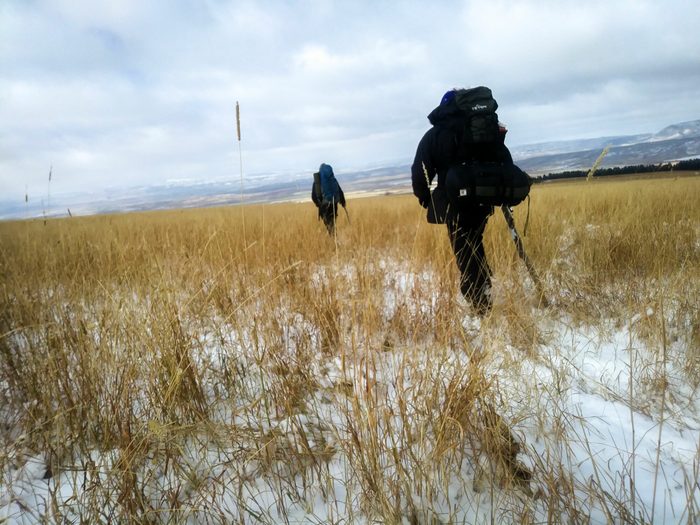
Proponents, though, call the swap a good compromise. Erica Lighthiser, deputy director of the local conservation organization Park County Environmental Council, is part of the working group that helped negotiate both the Porcupine Lowline reroute and this land swap. Asked if landowners are to blame for the access problems, Lighthiser instead said the checkerboard ownership system lies at the root. She saw the swap as a way to resolve access disputes, consolidate public land and protect what she described as a “fragmented” and “vulnerable” landscape.
But many people think this swap would make the Crazies more vulnerable, not less. One public commenter put it this way: “Only the misled and misinformed would consider horsetrading scenery for increasingly rare multi-species habitat.”
“Increasingly rare” because, here in the Greater Yellowstone Ecosystem, developers are rapidly turning this lowland habitat into luxury houses and resorts. According to Andy Hansen, an ecology professor at Montana State University, development has already consumed about half of the low-elevation ecosystem, and the pressures to develop the rest “are just overwhelming.”
The swap would consolidate public land but also private, opening much of the range to luxury development. In their own public comment, one of the parties to the exchange — the Carroccia family, owners of Sweet Grass Ranch, who would get some of the public land in the foothills and along Sweet Grass — dismissed fears of development as “completely unfounded.”
“As people who have worked our whole lives to protect, conserve, and maintain the land,” they wrote, “there is nothing more important to us than good stewardship.”
But the lack of protections against development has made even Lighthiser and the Park County Environmental Council, who have been instrumental in promoting the swap, hesitant about the deal as presently written. “Even if the current landowners have no intention of subdividing or selling their property,” the group wrote in recent public comments to the Forest Service, “this consolidated private land far up into the Sweet Grass Creek drainage will eventually be too valuable not to.”
Eventually may not be very far off. It’s easy to get lost in the complexities of this land exchange and lose sight of its place in the larger story of gentrification playing out across the West. Wealth is moving in, and companies are searching out new ways to squeeze money from the landscape. The long-time ranchers responsible for obstructing access to the Crazies may not have development dreams — but plenty of others do. By obstructing access to public land, these landowners have set the stage for a deal that would hand over choice sections of that land to them — at a time when the value of such land is going through the roof.
The Yellowstone Club — the ultra-exclusive resort community near Big Sky whose parent company now owns the Crazy Mountain Ranch — is a major player driving this land exchange. That’s because the Crazies swap is paired with another exchange 80 miles away, in the Madison Range, in which the Yellowstone Club would trade 605 acres of private land for 420 acres of National Forest to expand its private ski resort. The Forest Service had long refused to trade. Now, the agency made it clear that it would do so — but only if the club handled the pricey research and negotiations to broker the complicated east Crazies exchange.
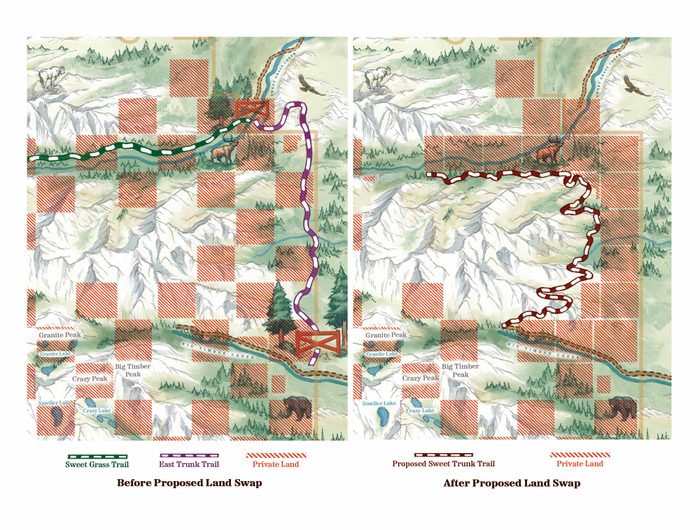
In 2018, the Yellowstone Club hired Western Land Group, a company that specializes in land exchanges, to do the legwork of hammering out the deal with Crazy Mountain landowners that it would eventually bring to the Forest Service.
“Western Land Group shows up where billionaires are trying to get public land for a pittance,” says Travis Stills, a Colorado-based lawyer who has been tracking land exchanges, and Western Land Group in particular, since the early 2000s. “If landowners had a proposal that was good enough to go through, they wouldn’t need these outside groups.”
In an emailed response to questions, Western Land Group founder Tom Glass wrote that “land exchanges with the U.S. Forest Service are strictly dictated by agency policy.” They are, Glass wrote, “subject to strict U.S. Department of Justice appraisal standards.”
Mike DuCuennois, the Yellowstone Club’s project lead for the land exchange, also responded to emailed questions: The proposed swap, DuCuennois wrote, would increase public access and improve trails in both mountain ranges.
Stills says it’s also common for landowners to threaten things valued by the public to force land agencies to the bargaining table. In the Valle Seco BootJack land exchange in Colorado, for example, billionaire Kelcy Warren — co-founder of Energy Transfer Partners, the company that built the Dakota Access Pipeline — bought the Valle Seco inholding in the San Juan National Forest, then locked a gate across a Forest Service road, according to the Forest Service’s environmental assessment. The road provided public access to thousands of acres of National Forest. If the agency declined to trade him lands adjacent to his nearby $46.5 million ranch in exchange for Valle Seco, the agency expected Warren would “proceed” with his plans to fence in the inholding, turn it into an elk farm and build a hunting lodge. The agency made the trade. (Warren did not respond to a request for comment.)
Land exchanges, Stills says, “are just invitations for corruption.” He points to a 2000 report by the Government Accountability Office (GAO) that studied 1,265 land exchanges and found that government agencies regularly overvalued the lands they acquired and undervalued the lands they traded away. The GAO recommended that Congress consider discontinuing the program.
This Crazies exchange, though, seems poised to go through: In September 2023, the Forest Service put out a draft decision notice that it planned to move forward with the exchange. The agency plans to release a final decision in the coming months.
I’ve been trying to write this story for more than five years now. One of the problems was the trespassing charge (and eventual conviction), which got me more personally involved in the story, editors have told me, than journalists are supposed to be.
The Crazies, and the battles over who gets access to them, have a way of becoming personal. I can’t think of the Crazies without thinking of my own family, because the life we’ve lived together is all tangled up with the land where we’ve lived it. When I was cleaning out my brother’s house this spring after his death, I found on his desk one of the few photographs in the place: a framed 5-by-7 of him, Dad and me sitting on a boulder in that high meadow where we made our camp, the scree slopes of Crazy Peak in the background.
But maybe land should be personal. Our times demand that all of us, wherever we live, deepen our relationships with the ecosystems we’re part of. This doesn’t happen through Instagram photos or roadside overlooks, but through participation in the land. For most of us, public land offers the only chance we have for that kind of participation, for building that kind of relationship.
District Ranger Sienkiewicz put it this way in a letter to one trail-blocking landowner: For most kids, “the national forest is the only ‘ranch’ they’ll ever own.”
Joseph Bullington grew up in the Smith River watershed near White Sulphur Springs, Montana. He is the editor of Rural America In These Times.

